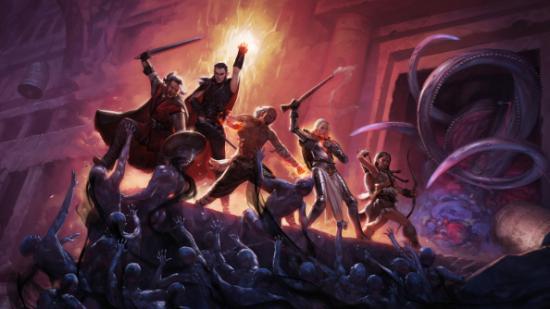Earlier this month, I sat in a slightly uncomfortable chair while Obsidian’s Josh Sawyer narrated an hour of monster murder in Pillars of Eternity. Alongside the fantastical adventuring and branching dialogue are plenty of battles. The party wandered through sprawling dungeons, gothic castles and clifftop forests, all full of a wide variety of nasties waiting to be set on fire or stabbed.
I’ve already played a few hours of the game, along with Jeremy, and when we had a fireside chat about it, we both confessed that we were a bit rusty when it came to Infinity Engine-style combat. It’s tricky, because it’s real-time and surprisingly fast-paced, but you need to approach it like turn-based tactical game, pausing it constantly.
There are plenty of difficulty levels, and ways to tailor the game to your playstyle, like setting it so the combat pauses when specific things happen. But even then, it can be tricky. That’s why there are alternatives to fighting.
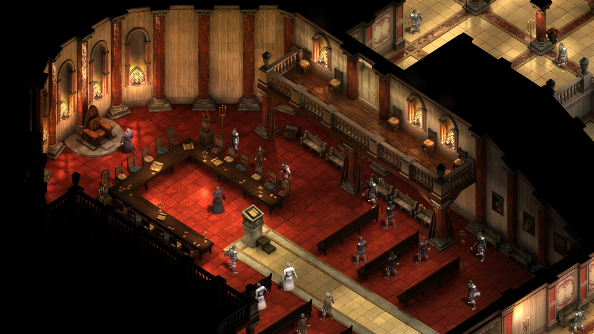
To start off the combat demo, the party actually avoids conflict. Sneaking through a gothic fortress lousy with priests and paladins, they come across a stash of robes. All dressed up in burlap, they’re able to get further into the complex without putting swords through anyone. Finding a disguise doesn’t guarantee success, though. The party is questioned by a priest, but manages to keep up the pretense thanks to their skills, which translate into conversation skills as well as combat ones.
Eventually, the good luck ends, and the party is spotted by a guard who doesn’t fall for their disguise. A brawl ensues. This is probably the fourth time in two days that the chap driving the demo has been in this fight, but it’s still clearly a tough one. It’s a maze of corridors and rooms with a veritable army of holy warriors, and the party’s stamina is whittled away. The situation could have been avoided, though.
“You can actually bluff your way through the whole level,” says Sawyer. “You don’t have to fight anyone.” But that requires characters with skills that can overcome an interrogation from several different guards, all who will ask different questions with different skill requirements.
The party is whisked away from the fortress to a gargantuan, cavernous dungeon, Endless Paths of Od Nua. “During the Kickstarter phase, we had this challenge,” says Sawyer. “‘Hey everybody, how big can we make this big, crazy mega-dungeon?’ That was kind of a mistake, because the answer was 15 levels.”
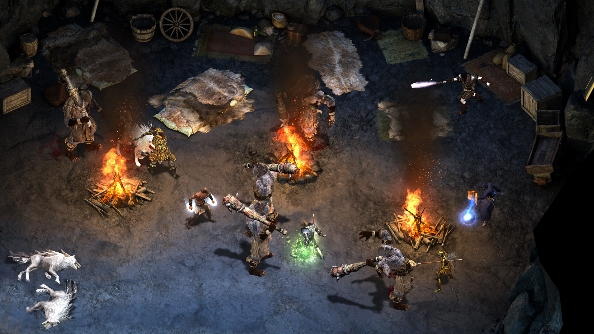
Endless Paths’ levels vary in size and the type of monsters found in them, but they are all big, and spreading throughout them are the limbs of a massive statue. As well as being an increasingly tough combat challenge, it’s all wrapped up in this story of the dungeon’s history.
“So as you go through the dungeon you’ll see different parts of him [the statue],” explains Sawyer. “You’ll see his hands, his head, his feet and everything, and learning the story of how that statue came to exist there and what it’s doing in there is a big part of unlocking the mystery of Endless Paths.”
As soon as the party starts its journey through level eight of Endless Paths, they almost step right on a trap. In Pillars of Eternity, stealth mode doubles as a searching for traps mode, and when they are disabled, they can also be recovered and then used against the buggers that put them there in the first place.
Even with spells going off in all directions – many of which should be familiar to D&D or Baldur’s Gate players – Pillars of Eternity’s combat isn’t much fun to watch. It’s all a bit messy and chaotic if you don’t know what’s going on, if you’re not there, giving the orders to the party yourself. But once you understand the rules and character’s abilities, things start to become a lot easier to read.
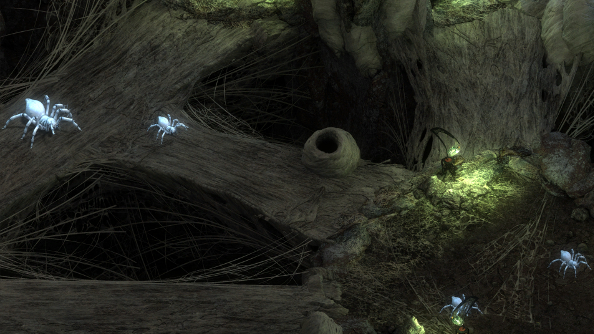
Knowing that all types of plate armour are weak against electricity, for example, makes it easy to understand why your knight is having so much trouble now that a mage has bathed the battlefield in a spiderweb of electricity.
After fighting priests, paladins and undead, it was time to fight a dragon. Well, not a full grown dragon, but a drake. Drake, dragon, it doesn’t mean much when you’re running away from one as it breathes fire down on your head. I wondered if this type of challenge could just be wandered into at any level. Sawyer explained that it’s in an area that players won’t have access to right away, but there are lots of places for a party to explore off the beaten track.
“You can explore, and we try to allow players to do that as much as possible. Obviously we don’t want the player to feel shitty for looking around. We always try to place things in the environment that makes them feel like they’re rewarded for taking on that challenge. I will say that a lot of the side content is specifically made to be more challenging than the critical path. Play the critical path, and it’ll be kind of challenging, but if you go off the beaten path, that’s where you find the really nasty challenges.”
Most of Pillars of Eternity’s content will be found outside of the critical path, the main story, and exploring new areas or undertaking sidequests is the only way to reach the maximum level by the end of the game.
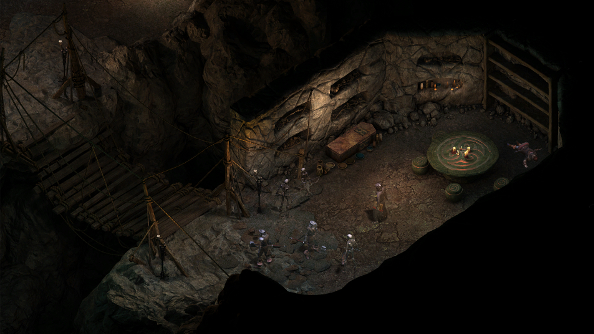
“I’d say about two thirds to three quarters of the game’s content is completely optional,” says Sawyer. Obsidian has tried to strike a balance between Baldur’s Gate, which had loads of wilderness areas, but not much going on in them, and Baldur’s Gate II, which was richer in content but more condensed, with less proper exploring.
The drake and its crazy worshippers are tough cookies, but like all enemies in Pillars of Eternity, their weaknesses can be read in an mini character sheet excerpts displayed in the top left corner. But what information is displayed depends on how much experience the party has with that particular enemy.
When first encountering a foe, the box will just be filled with question marks, but as you fight them, the status effects and damage shows up, giving a fairly detailed look at the state the monster is in. By fighting monsters, you start to unlock entries in the Bestiary. This tomb contains knowledge both mundane and esoteric on each type of creature the party has faced, which is then translated into important combat information. But it’s a guide, not exact, until you actually start fighting them, then that individual creature’s information gets filled in.

As well as those info cards, there’s a combat HUD which shows – in the form of pips – how much health enemies and allies have, as well as how long it will take for the next action to be available. To make things trickier, or simply to make the screen less busy, the combat HUD can be turned off.
Sawyer says that it’s been difficult to create options to suit almost everyone, but worthwhile. “We have a lot of very passionate fans, and it’s not their job to have one single vision and desire. They’re all going to have their own preferences , and as long as us supporting those different options doesn’t make the game fundamentally worse, we try to do it whenever we can.”
The optional combat HUD, the Bestiary – these all seem to be an attempt to provide players with lots of information without overwhelming them. This extends to the detailed combat log. Like the old Infinity Engine games, Pillars of Eternity reveals a slew of numbers, effects and jargon in a window at the bottom of the screen, but it’s up to the player to choose how far down the rabbit hole they go.
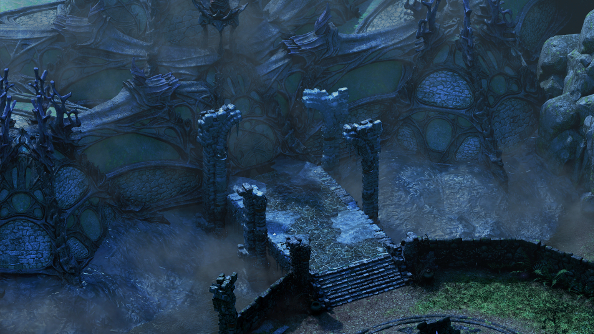
“We try to let you see all the actions that are happening and the basic results of them, and if you want to get more detail, when you hover it gives you the full breakdown of what happened,” explains Sawyer. “We also have started doing things like grouping similar effects together. So when someone casts fireball, instead of having eight entries like ‘This dude got crit for this much damage, this guy got missed for this much…’ Yeah dude, just give me the short version.”
Nobody likes to miss on an attack roll. And in Infinity Engine games, that happened a lot. In Pillars of Eternity, however, damage is more consistent thanks to “grazing”. It normalises damage. The outcome is no longer hit for a lot of damage or completely miss, instead you can miss and just graze an enemy, doing 50 percent damage or, in the case of spells, it will be 50 percent status effect duration.
Back in the drake fight, everyone has giant heads. The rogue’s hat takes up most of the screen’s real estate, and flying above the party is a gargantuan reptilian head attached to a tiny body, utterly defying physics – something that dragons are, admittedly, good at. The party finally manages to bring the drake back down to earth, stunning it and then laying into it. He’s done for. The poor thing’s wings twitch as it’s battered by swords and axes and magic. But everything has a massive head, so it’s not quite as tragic.
You’ll be able to abuse dragons and countless other fantasy monsters yourself when Pillars of Eternity launches on March 26th.
